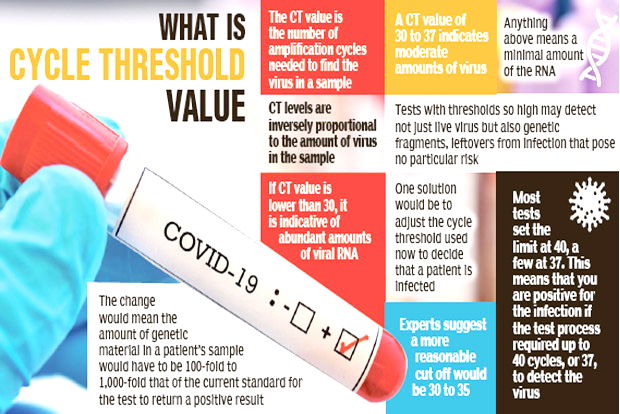Science & Technology
Variability in Ct Values
- 28 Feb 2022
- 4 min read
For Prelims: Viral Load, Ct Values, RT-PCR Test.
For Mains: Significance of Ct Value in RT-PCR Test and factors of its Variability.
Why in News?
Recently, a survey of 700 laboratories in the US using standardised proficiency testing material from the same batch found a variability in Ct (Cycle Threshold) values by 14 cycles.
- Even within the same test at the same lab the Ct values could vary by 3 cycles for different target genes, and up to 12 cycles for the same target gene across labs.
What is the Cause of Variability in Ct Values?
- Dynamic Measure and Evolves Rapidly:
- A low Ct value at the time of diagnosis does not mean that it will stay low the next day.
- Similarly, a swab done very early in the infection may reveal a high Ct value, which if repeated a day or two later, may reveal a lower Ct value.
- It is possible for this reason that Ct values have not been convincingly correlated with disease severity, and serve no role in predicting the trajectory for a patient (yet, this is commonly used as an argument to prescribe tests and medicines).
- Influence of Technical and Logistical factors:
- The way specimens are collected, the type of specimen, the medium in which the swab is transported, the time lag between collection of the specimen and processing.
- All of this can influence the quantum of viral genetic material present, and subsequently, the Ct value.
What is RT-PCR Test and Ct Value?
- RT-PCR Tests:
- In an RT-PCR (Reverse Transcription Polymerase Chain Reaction) test, RNA (Ribonucleic acid) is extracted from the swab collected from the patient. It is then converted into DNA (Deoxyribonucleic acid), which is then amplified.
- Amplification refers to the process of creating multiple copies of the genetic material - in this case, DNA.
- This improves the ability of the test to detect the presence of the virus.
- Amplification takes place through a series of cycles—one copy becomes two, two becomes four, and so on—and it is after multiple cycles that a detectable amount of virus is produced.
- Ct Value:
- Ct is short for ‘Cycle Threshold’.
- The Ct value refers to the number of cycles after which the virus can be detected.

- If a higher number of cycles is required, it implies that the virus went undetected when the number of cycles was lower.
- The lower the Ct value, the higher the viral load-because the virus has been spotted after fewer cycles.
- It has been found that the time since the onset of symptoms has a stronger relationship with Ct values as compared to the severity of the disease.
What is Viral Load?
- It refers to the amount of genetic material, commonly RNA, of a virus present in an infected person’s blood.
- This is expressed as the total number of viral particles present in each millilitre of blood.
- A higher viral load in the blood means that the virus is replicating and the infection is progressing.
- An infected person with a high viral load is more likely to shed more virus particles, in the process known as “viral shedding”.




